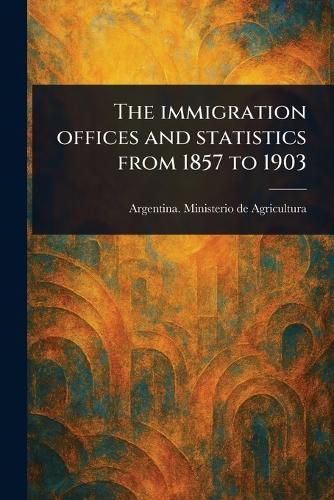Readings Newsletter
Become a Readings Member to make your shopping experience even easier.
Sign in or sign up for free!
You’re not far away from qualifying for FREE standard shipping within Australia
You’ve qualified for FREE standard shipping within Australia
The cart is loading…






This title is printed to order. This book may have been self-published. If so, we cannot guarantee the quality of the content. In the main most books will have gone through the editing process however some may not. We therefore suggest that you be aware of this before ordering this book. If in doubt check either the author or publisher’s details as we are unable to accept any returns unless they are faulty. Please contact us if you have any questions.
Delve into Argentina's rich history of immigration with "The immigration offices and statistics from 1857 to 1903," a meticulously preserved historical document from The Argentine Ministry of Agriculture. This essential resource offers a detailed statistical analysis of emigration and immigration patterns during a pivotal period in Argentina's development. Explore government records and statistical data that shed light on the complex social and demographic shifts shaping the nation.
Focusing on the period from 1857 to 1903, this volume provides valuable insights into the policies and processes of the immigration offices. A key historical record, it is ideal for researchers, historians, and anyone interested in Latin American history, demography, and the enduring impact of emigration and immigration on national identity. Discover the statistical foundations that underpin our understanding of Argentina's past.
This work has been selected by scholars as being culturally important, and is part of the knowledge base of civilization as we know it.
This work is in the public domain in the United States of America, and possibly other nations. Within the United States, you may freely copy and distribute this work, as no entity (individual or corporate) has a copyright on the body of the work.
Scholars believe, and we concur, that this work is important enough to be preserved, reproduced, and made generally available to the public. We appreciate your support of the preservation process, and thank you for being an important part of keeping this knowledge alive and relevant.
$9.00 standard shipping within Australia
FREE standard shipping within Australia for orders over $100.00
Express & International shipping calculated at checkout
This title is printed to order. This book may have been self-published. If so, we cannot guarantee the quality of the content. In the main most books will have gone through the editing process however some may not. We therefore suggest that you be aware of this before ordering this book. If in doubt check either the author or publisher’s details as we are unable to accept any returns unless they are faulty. Please contact us if you have any questions.
Delve into Argentina's rich history of immigration with "The immigration offices and statistics from 1857 to 1903," a meticulously preserved historical document from The Argentine Ministry of Agriculture. This essential resource offers a detailed statistical analysis of emigration and immigration patterns during a pivotal period in Argentina's development. Explore government records and statistical data that shed light on the complex social and demographic shifts shaping the nation.
Focusing on the period from 1857 to 1903, this volume provides valuable insights into the policies and processes of the immigration offices. A key historical record, it is ideal for researchers, historians, and anyone interested in Latin American history, demography, and the enduring impact of emigration and immigration on national identity. Discover the statistical foundations that underpin our understanding of Argentina's past.
This work has been selected by scholars as being culturally important, and is part of the knowledge base of civilization as we know it.
This work is in the public domain in the United States of America, and possibly other nations. Within the United States, you may freely copy and distribute this work, as no entity (individual or corporate) has a copyright on the body of the work.
Scholars believe, and we concur, that this work is important enough to be preserved, reproduced, and made generally available to the public. We appreciate your support of the preservation process, and thank you for being an important part of keeping this knowledge alive and relevant.